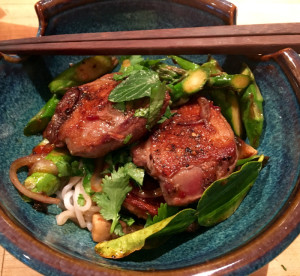People love comfort food. Look at the menus at even the most high-end restaurants over the last few years and you’ll find variations on just-like-mom-used-to-make foods like mac ‘n cheese, pudding, fried chicken, cookies and milk, and grilled cheese.
But we are living in a melting pot of cultures from around the world. Not everyone’s food hug is the same. Your food hug might come in the form of pho, shakshuka, or Panang curry.
When the U.S. economy tanked in 2008, it wasn’t a great time to shell out piles of cash to open a brick-and-mortar restaurant. As a result, some seriously talented chefs took to the streets and the modern food truck movement was born.
In an LA Times article, Chef Roy Choi describes how his family emigrated from Korea to L.A. where he grew up with the smells of “kimchi and sour soybean paste” and the flavors of “salted, aged fish eggs and grilled pig intestines.”
He combined the foods of his childhood with the concept of the taco truck commonly seen on the streets of L.A. Choi has been serving up cross-cultural food hugs out of his very popular Kogi’s BBQ Truck since then, and this approach to food continues to be on trend in the culinary world today.
What The Food Industry Is Saying
The National Restaurant Association (NRA) has released its annual report, Top Restaurant Menu Trends of 2016 (report no longer available). According to the report, which is based on feedback from 1,575 members, ethnic condiments and spices are the 11th biggest food trend of the year and ethnic-inspired breakfast items are the 16th. Also standing out as hot trends this year are authentic ethnic cuisine, ethnic fusion cuisine, Latin American, and African flavors.
At FDR, we agree with the survey respondents of the NRA report and see today’s prevalence of global flavors in the US as a homesick phone call made to mom, food in hand, from a bustling street corner in Asia. Now that the economy is much improved since 2008, this at-one-time small trend is thankfully ready to go mainstream.
7 Culinary Explosions We Expect To See
1. A cross-cultural approach. You say fusion, we say cross-cultural. Italian drawing on Japanese flavors. Korean with Mexican garnishes. The world is getting smaller, so calling this a “trend” is a bit of a misnomer.
2. In-house fermented ingredients. Kimchi, miso, and pickled everything.
<< Get a kimchi bloody mary recipe here. >>
3. New/different cuts of meat. Traditionally underappreciated in new American cuisine, but fundamental in many international cuisines. Think spinalis, coulotte steak, and chicken thighs. And, don’t worry, pork belly isn’t going anywhere.
4. Asian street food. Bold, inexpensive, accessible, and portable…need we say more? This food truck staple will show up even more as fast-casual concepts continue to grow.
5. Southeast Asian restaurants. Yes, we all know and love Vietnamese and Thai food. Dig a little deeper. Cambodian, Philippine, and Burmese restaurants are amazing and will become more mainstream this year.
6. African-inspired flavors. We’re not talking soul food here. African cuisine is relatively unknown in the U.S., and chefs will increasingly explore these flavors in their cooking. According to this year’s NRA report, African flavors are up 20% from 2015 to 2016. The New York Times describes how Joseph Johnson, the executive chef at the Cecil and Minton’s in Harlem, “builds flavors from an Africa-inspired version of the French mirepoix: his involves bird’s eye chiles, onion, tomato, garlic, shallots, and ginger.”
<< Read more about the trend in this blog post from FDR >>
7. Newish Jewish. The food hug from your Jewish grandmother. Jewish deli food is becoming trendy thanks to a new generation of chefs. Look for locally-sourced ingredients, corned beef made in-house, and authentic, artisan bagels.
Need some fresh Southeast Asian inspiration right now? Check out our recipe for Thai Squab right here.
California Thai Squab Kumquat Marmalade Noodle Bowl
Ingredients
- 4 ea Whole Squab (remove breasts and leg/thighs)
- 1 TB Kosher Salt
- 2 tsp Black Pepper
- ¼ cup Kumquat Marmalade
- 2 TB Sambal
- 2 TB Soy Sauce
- 1 TB Sesame Oil
- 2 cups White Mushrooms, quartered
- ½ cup Red Onions, Sliced
- 2 cups Asparagus, Slice in 2” pieces on angle
- 1 ea Serrano Pepper, Sliced
- 1 stalk Lemon Grass, beaten and sliced into 2” pieces
- 4 ea Garlic Cloves, Sliced
- 3 ea Kaffir Lime Leaves
- 1 package Rice Noodles, cooked according to package directions, set aside
- 1 bunch Mint, Leaves removed and roughly chopped
- 1 bunch Cilantro, Leaves removed and roughly chopped
Instructions
- Season Squab breasts and legs/thighs with Kosher salt and black pepper.
- In small mixing bowl stir together Kumquat marmalade, Sambal and soy sauce, set aside.
- Heat Wok (or large sauté pan) over high heat. Add 1 TB Sesame oil
- Place Squab in pan skin side down in pan and brown for 4 minutes flip over and finish for 2 more minutes, remove from pan and set aside.
- Add the other tablespoon of sesame oil to pan, add mushroom, asparagus, serrano pepper, lemongrass, garlic, Kaffir lime leaves and stir fry for 2 minutes.
- Add squab and sauce into wok (or sauté pan) toss and warm through for one minute.
- Add noodles and toss and warm through for 30 seconds.
- Remove from heat and add mint and cilantro, toss.
- Place noodles first in bowls then top with squab and veggies. Pour sauce over.
- Serve immediately.

Thanks for stopping by and reading the Food & Drink Resources blog. Here we talk about food trends, culinary innovation, and the work of our team.
